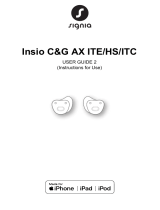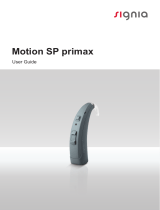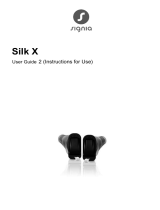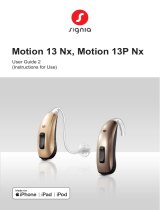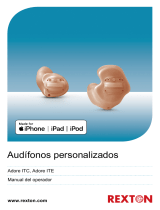La página se está cargando...

Insio™ Nx ITC, Insio Nx ITE
USER GUIDE 2
(Instruction for Use)
Custom Instruments

Caution
It is important to read this user guide and the
user guide 1 (safety manual) thoroughly and
completely. Follow the safety information to
avoid damage or injury.

Content
Welcome 4
Your hearing inruments 5
Instrument type 5
Getting to know your hearing instruments 6
Components and names 6
Controls 7
Hearing programs 9
Features 9
Batteries 10
Battery size and handling tips 10
Replacing batteries 11
Daily use 12
Turning on and off 12
Inserting and removing the hearing instruments 13
Adjusting the volume 15
Changing the hearing program 15
Further adjustments (optional) 15
Special liening situations 16
On the phone 16
Audio streaming with iPhone 17
Airplane mode 17
3

Maintenance and care 18
Hearing instruments 18
Professional maintenance 19
Further information 20
Safety information 20
Accessories 20
Symbols used in this document 20
Troubleshooting 21
Country-specific information 22
Service and warranty 23
4

Welcome
Thank you for choosing our hearing instruments to
accompany you through everyday life. Like anything new,
it may take you a little time to become familiar with them.
This guide, along with support from your Hearing Care
Professional, will help you understand the advantages
and greater quality of life your hearing instruments offer
To receive the most benefit from your hearin
instruments, it is recommended that you wear them every
day, all day. This will help you get adjusted to them
CAUTION
It is important to read this user guide and the safety
manual thoroughly and completely. Follow the
safety information to avoid damage or injury.
Enhance your Signia experience
Learn about your hearing aids and accessories you may
nd helpful, access the latest information about hearing
health, and receive promotional offers by joining the
Signia hearing health community at*
www.signiausa.com/join or:
Learn more
about Signia
products by
scanning the
QR code
* We respect your privacy. We will
not sell, rent, or give your name
or e-mail address to anyone. At
any time, you can select a link
at the bottom of every email to
unsubscribe or update prole.
5

Your hearing inruments
This user guide describes optional features that
your hearing instruments may or may not have
Ask your Hearing Care Professional to indicate the
features that are valid for your hearing instruments
Inrument type
Your hearing instruments are customized models tha
have been individually manufactured based on the
anatomy of your ears. They are worn directly in the
ear, either in the bowl of the ear or deep inside the ear
canal. They are not intended for children under the age
of 3 years or persons with a developmental age of under
3 years.
The wireless functionality enables advanced audiological
features and synchronization between your two hearing
instruments
Your hearing instruments feature Bluetoot ® low energy*
technology allowing for easy data exchange with your
smartphone, and for seamless audio streaming with your
iPhone**.
* The Bluetooth word mark and logos are owned by the Bluetooth SIG, Inc., and any
use of such marks by the legal manufacturer of this product is under licenses. Other
trademarks and trade names are those of their respective owners.
** iPad, iPhone, and iPod touch are trademarks of Apple Inc., registered in the U.S.
and other countries.
6

Getting to know your hearing inruments
It is recommended to familiarize yourself with your new
hearing instruments. With the instruments in your han
try using the controls and note their location on the
instrument. This will make it easier for you to feel and
press the controls while wearing the hearing instruments
If you have problems pressing the controls of your
hearing instruments while wearing them, you can
use a smartphone app to control your instruments
Components and names
This user guide describes several types of hearing
instruments. Use the following pictures to identify the type
of hearing instrument that you use
Note that the push button and vent are individually
positioned on your hearing instrument to best suit you
ear. The appearance of your hearing instruments may
therefore differ from that of those pictured
ITC (In The Canal)
➊
➌
➍
➎
➋
➊ Microphone
➋Push button
➌Second microphone
➍Battery compartment
➎Vent (optional)
7

ITE (In The Ear)
➊
➋
➌
➍
➎
➊Microphone
➋Push button
➌Second microphone
➍Battery compartment
➎Vent (optional)
Controls
With the push button you can, for example, switch
hearing programs. The Hearing Care Professional has
programmed your desired functions to the push button.
You can use a smartphone app for remote control.
8

Push button function L R
Press briefly
Program up
Volume up
Volume down
Tinnitus therapy signal level up
Tinnitus therapy signal level down
TV stream on/o
Press for about 2 seconds:
Program up
Volume up
Volume down
Tinnitus therapy signal level up
Tinnitus therapy signal level down
TV stream on/o
Activate/deactivate airplane mode
Press for more than 3 seconds:
Standby/turn on
L = Left, R = Right
9

Hearing programs
1
2
3
4
5
6
Read more in section "Changing the hearing program".
Features
Power-on delay enables whistle-free insertion of
hearing instruments
Read more in section "Turning on and off"
The tinnitus therapy feature generates a sound to
distract you from your tinnitus
10

Batteries
When the battery is low the sound becomes weaker
or you will hear an alert signal. The battery type will
determine how long you have to replace the battery.
Battery size and handling tips
Ask your Hearing Care Professional for recommended
batteries.
Battery size: 312
●Always use the correct battery size for your hearing
instruments
●Remove the batteries if you intend not to use the
hearing instruments for several days
●Always carry spare batteries.
●Remove empty batteries immediately and follow your
local recycling rules for battery disposal.
11

Replacing batteries
Removing the battery:
XOpen the battery
compartment.
XRemove the battery
by hand.
Inserting the battery:
XIf the battery has a protective film, remove i
only when you are ready to use the battery.
XInsert the battery with the
"+" symbol facing upwards.
XCarefully close the battery compartment. If you feel
resistance, the battery is not inserted correctly
Do not attempt to close the battery compartment by
force. It can be damaged.
12

Daily use
Turning on and o
You have the following options to turn your hearing
inruments on or o.
Via battery compartment:
XTurning on: Close the battery compartment.
The default volume and hearing program are set.
XTurning off: Open the battery compartment fully
Via push button:
XTurning on or off: Press and hold the pus button for
several seconds. Refer to section "Controls" for the
settings of your controls.
After turning on, the previously used volume and
hearing program remain set.
When wearing the hearing instruments, an alert tone can
indicate when an inrument is being turned on or o.
When the power-on delay is activated, the hearing
instruments turn on after a delay of several seconds.
During this time you can insert the hearing instruments
into your ears without experiencing unpleasant feedback
whistling
The "power-on delay" can be activated by your Hearing
Care Professional.
13

Inserting and removing the hearing inruments
Your hearing instruments have been fine-tuned for you
right and left ear. The labeling on the hearing instruments
indicates the side:
●"R" = right ear
●"L" = left ear
Inserting a hearing instrument
XCarefully push the hearing
instrument into th
ear canal.
XTwist it slightly until i
sits well.
Open and close
your mouth to avoid
accumulation of air in
the ear canal.
14

Removing a hearing instrument
NOTICE
Never pull on the battery compartment door to
remove the hearing instrument. This could damage
your hearing instrument
XPush lightly on the back of your ear to loosen the
hearing instrument
XGrip the hearing instrumen
in the ear canal with two
fingers and pull it carefull
out.
Clean and dry your hearing instruments after usage.
Read more in section "Maintenance and care".
15

Adjuing the volume
Your hearing instruments automatically adjust the volum
to the listening situation
XIf you prefer manual volume adjustment, press th
push button.
Refer to section "Controls" for the setting of your
push button.
An optional signal can indicate the volume change.
Changing the hearing program
Depending on the listening situation, your hearing
instruments automatically adjust their soun
Your hearing instruments may also have several hearing
programs which allow you to change the sound, if
needed. An optional signal tone can indicate the program
change.
XTo change the hearing program, press the push button
briefly
Refer to section "Controls" for the setting of your
controls. Refer to section "Hearing programs" for a li
of your hearing programs.
The default volume is applied.
Further adjuments (optional)
You can also use the hearing instrument controls to
change other features, for example, the level of the
tinnitus therapy signal.
Refer to section "Controls" for the setting of your controls.
16

Special liening situations
On the phone
When you are on the phone, turn the
receiver slightly so that it does not
completely cover your ear.
Telephone program
You may prefer a certain volume when using the phone.
Ask your Hearing Care Professional to configure a
telephone program.
XSwitch to the telephone program whenever you are on
the phone.
If a telephone program is configured for your hearin
instruments, it is listed in section "Hearing programs
17

Audio reaming with iPhone
Your hearing instruments are Made for iPhone hearing
instruments. This means you can get phone calls and
listen to music from your iPhone directly into your hearing
instruments
For more information about compatible iOS devices,
pairing, audio streaming and other useful functions,
contact your Hearing Care Professional.
Airplane mode
In areas where the use of Bluetooth technology is not
allowed (e.g. on some airplanes), you can activate the
airplane mode. This turns Bluetooth in your hearing
instruments off temporarily. The hearing instruments st
work without Bluetooth, however direct audio streaming
will not be possible and other functions will not be
available.
XTo activate or deactivate the airplane mode, use the
smartphone app or use the controls of your hearing
instruments
Refer to section "Controls" for more information.
An alert tone indicates when airplane mode is activated
or deactivated.
18

Maintenance and care
To prevent damage it is important that you take care of
your hearing instruments and follow a few basic rules,
which will soon become a part of your daily routine.
Hearing inruments
Drying and orage
XDry your hearing instruments overnight
XFor longer periods of non-use, store your hearin
instruments in a dry environment with an open batter
compartment and the batteries removed.
XAsk your Hearing Care Professional for more
information.
Cleaning
For hygiene reasons and to maintain functionality, clean
your hearing instruments daily
XClean your hearing instruments daily with a soft, dr
tissue.
XYour hearing instrument
may have a wax protection.
This prevents the ingress
of earwax. Be careful not to
damage the wax protection
when cleaning your hearing
instruments
19

XNever use running water or immerse the
devices in water.
XNever apply pressure while cleaning.
XAsk your Hearing Care Professional for recommended
cleaning products, special care sets, or more
information on how to keep your hearing instrument
in good condition.
Professional maintenance
Your Hearing Care Professional can perform a thorough
professional cleaning and maintenance.
In the event that the wax protection or microphone
protection (windscreen) needs to be replaced, this should
be carried out by a professional.
Ask you Hearing Care Professional for your individual
recommendation of maintenance intervals and for
support.
20

Further information
Safety information
For more safety information, refer to the safety manual
supplied with the device.
Accessories
The type of available accessories depends on the
instrument type. Examples are: an audio streamin
device or a smartphone app for remote control.
Consult your Hearing Care Professional for further
information.
Symbols used in this document
Points out a situation that could lead to serious,
moderate, or minor injuries.
Indicates possible property damage.
Advice and tips on how to handle your device
better.
"Made for iPhone", "Made for iPad",
and "Made for iPod" mean that an electronic accessory
has been designed to connect specifically to iPhone,
iPad, or iPod, respectively, and has been certified by the
developer to meet Apple performance standards. Apple
is not responsible for the operation of this device or its
21

compliance with safety and regulatory standards. Please
note that the use of this accessory with iPhone, iPad, or
iPod may affect wireless performance
Troubleshooting
Problem and possible solutions
Sound is weak.
●Increase the volume.
●Gently close the battery compartment completely.
●Clean the hearing instrument
●Replace the empty battery.
●Ask your Hearing Care Professional to exchange
the wax protection and/or the microphone cover.
Hearing instrument emits whistling sound
●Reinsert the hearing instrument until it fi
securely.
●Decrease the volume.
●Clean the hearing instrument
Sound is distorted
●Decrease the volume.
●Replace the empty battery.
●Clean the hearing instrument
●Ask your Hearing Care Professional to exchange
the wax protection and/or the microphone cover.
Hearing instrument emits signal tones
●Replace the empty battery.
22

Problem and possible solutions
Hearing instrument does not work
●Turn the hearing instrument on
●Gently close the battery compartment completely.
●Replace the empty battery.
●Make sure the battery is inserted correctly.
●Power-on delay is active. Wait several seconds
and check again.
Consult your Hearing Care Professional if you encounter
further problems.
Country-specic information
USA and Canada
Certification information for hearing instruments wit
wireless functionality:
Insio Nx ITC, Insio Nx ITE
●HVIN: WP4N1
●Contains FCC ID: SGI-RFM001
●IC: 267AB-WP4N1
23

Service and warranty
Serial numbers
Left:
Right:
Service dates
1: 4:
2: 5:
3: 6:
Warranty
Date of purchase:
Warranty period in months:
Your Hearing Care Professional
24

Audífonos personalizados
Insio™ Nx ITC, Insio Nx ITE
MANUAL DEL OPERADOR 2
(Instrucciones de uso)

Caution
IEs importante que leas detenidamente este
manual del operador y el manual del operador
1 (manual de seguridad) de principio a fin.
Sigue la información de seguridad para evitar
daños o lesiones.

Contenidos
Bienvenido 4
Los audífonos 5
Tipo de audífono 5
La importancia de conocer el audífono 6
Componentes y nombres 6
Controles 7
Programas de audición 9
Características 9
Pilas 10
Tamaño de la pila y consejos para el manejo 10
Sustituir las pilas 11
Uso diario 12
Conexión y desconexión 12
Inserción y extracción de los audífonos 14
Regulación del volumen 16
Cambio del programa de audición 16
Más ajustes (opcional) 17
Situaciones de escucha especiales 18
Al teléfono 18
Transmisión de audio con iPhone 19
Modo avión 19
3

Mantenimiento y cuidados 20
Audífonos 20
Mantenimiento profesional 21
Información adicional 22
Información de seguridad 22
Accesorios 22
Símbolos utilizados en este documento 22
Solución de problemas 23
Información específica por país 25
Servicio y garantía 26
4

Bienvenido
Gracias por elegir nuestros audífonos para que le
acompañen en su vida cotidiana. Como todas las cosas
nuevas, es posible que tarde un poco en familiarizarse
con ellos.
Este manual, junto con la asistencia de su especialista
audición, le ayudará a conocer las ventajas y la calidad
de vida superior que le ofrecen los audífonos.
Para obtener el máximo beneficio posible de los
audífonos, se recomienda que los lleve a diario y durante
todo el día. Esto le ayudará a adaptarse a ellos
ATENCIÓN
Es importante que lea detenidamente este manual
del operador y el manual de seguridad de principio
a fin. Siga la información de seguridad para evitar
daños o lesiones.
Mejore su experiencia Signia
Los accesorios que le puedan ser útiles, acceda a
la información más reciente sobre salud auditiva y
reciba ofertas promocionales al formar parte de la
comunidad de salud auditiva de Signia en*
www.signiausa.com/join o:
* Respetamos su privacidad. No venderemos ni
alquilaremos ni daremos su nombre o dirección
de correo electrónico a nadie. Para cancelar su
suscripción o para actualizar sus datos, usted puede
seleccionar el enlace que aparece en la parte inferior
del correo electrónico, en cualquier momento.
Para conocer
más acerca de
los productos de
Signia escanee
el código QR .
5

Los audífonos
En este manual del operador se describen
características opcionales que sus audífonos
pueden tener o no tener.
Solicite al especialista en audición que le indique
qué características son válidas para sus audífonos
Tipo de audífono
Los audífonos son modelos personalizados que se han
fabricado específicamente para la anatomía de sus
oídos. Se colocan directamente en el oído, ya sea en la
cavidad de la oreja o introducidos en el canal auditivo.
No se han diseñado para niños menores de 3 años ni
para personas cuya edad de desarrollo esté por debajo
de los 3 años.
La funcionalidad inalámbrica proporciona características
audiológicas avanzadas entre los dos audífonos.
Los audífonos incorporan la tecnología
Bluetooth® low energy*, que permite intercambiar datos
de manera sencilla con su smartphone y transmitir audio
sin problemas con su iPhone**.
* La marca del término Bluetooth y sus logotipos son propiedad de Bluetooth SIG,
Inc. y el uso de dichas marcas por parte del fabricante autorizado se realiza bajo
licencia. Las demás marcas registradas y nombres comerciales pertenecen a sus
respectivos propietarios.
** iPad, iPhone y iPod touch son marcas registr das de Apple Inc. en EE. UU. y en
otros países.
6

La importancia de conocer el audífono
Se recomienda familiarizarse con el nuevo audífono. Con
el instrumento en la mano, intente utilizar los controles
y recordar su ubicación en el instrumento. Esto facilit
la localización de los controles para pulsarlos al llevar el
audífono puesto
Si tiene problemas para pulsar los controles de
los audífonos cuando los lleva puestos, puede
controlar los audífonos con una aplicación para
smartphone.
Componentes y nombres
En este manua del operador se describen diversos
tipos de audífonos. Utilice las imágenes siguientes para
identificar su tipo de audífono
Tenga en cuenta que tanto el pulsador como el
respiradero están colocados individualmente en el
audífono para adaptarse mejor a su oído. Por lo tanto,
el aspecto de los audífonos puede diferir de los de las
imágenes.
7

ITC (In The Canal)
➊
➌
➍
➎
➋
➊ Micrófono
➋Pulsador
➌Segundo micrófono
➍Compartimento de la pila
➎Respiradero (opcional)
ITE (In The Ear)
➊
➋
➌
➍
➎
➊Micrófono
➋Pulsador
➌Segundo micrófono
➍Compartimento de la pila
➎Respiradero (opcional)
Controles
Con el pulsador podrá, por ejemplo, cambiar de
programa de audición. Su especialista en audición ha
programado las funciones deseadas en el pulsador.
También puede utilizar una aplicación para
smartphone como telemando.
8

Función del pulsador L R
Pulsación corta:
Subir programa
Subir volumen
Bajar volumen
Subir nivel de señal terapéutica para
Tinitus
Bajar nivel de señal terapéutica para
Tinitus
Transmisión de TV activada/desactivada
Pulsación durante 2 s aprox.:
Subir programa
Subir volumen
Bajar volumen
Subir nivel de señal terapéutica para
Tinitus
Bajar nivel de señal terapéutica para
Tinitus
Transmisión de TV activada/desactivada
Activar/Desactivar el modo avión
Pulsación durante más de 3 s:
En espera/Conectar
L = izquierda (Left), R = derecha (Right)
9

Programas de audición
1
2
3
4
5
6
Obtenga más información en la sección
"Cambio del programa de audición".
Caracteríicas
El retardo de la conexión activa la inserción de
audífonos sin silbidos.
Obtenga más información en la sección
"Conexión y desconexión".
La función terapéutica para acúfenos genera un
ruido para distraerle de los acúfenos
10

Pilas
Cuando el nivel de la pila es bajo, el sonido se vuelve
más débil o se oye una señal de alerta. El tipo de
pila determinará el tiempo disponible hasta tener que
sustitui la pila.
Tamaño de la pila y consejos para el manejo
Solicite las pilas recomendadas a su especialista en
audición.
Tamaño de la pila: 312
●Utilice siempre el tamaño de pila adecuado para sus
audífonos.
●Extraiga las pilas si no va a usar los audífonos durante
varios días.
●Lleve siempre pilas de repuesto
●Extraiga inmediatamente las pilas descargadas y siga
la normativa local de reciclaje para eliminar las pilas.
11

Suituir las pilas
Retirar la pila:
XAbra el compartimento
de la pila.
XExtraiga la pila
manualmente.
Colocar la pila:
XSi la pila tiene una película protectora,
retírela solo cuando vaya a utilizar la pila.
XInserte la pila con el
símbolo "+" hacia arriba.
XCierre el compartimento de la pila con cuidado. Si
nota resistencia, es que la pila no está bien colocad
No intente cerrar el compartimento de la pila haciendo
fuerza. Puede dañarlo.
12

Uso diario
Conexión y desconexión
Dispone de las siguientes opciones para conectar y
desconectar los audífonos.
Con el compartimento de la pila:
XConexión: Cierre el compartimento de la pila.
Se restablecen el volumen y el programa de audició
predeterminados.
XDesconexión: Abra totalmente el compartimento de la
pila.
Con el pulsador:
XConexión o desconexión: Pulse y mantenga pulsado
el pulsador durante varios segundos. Consulte
la configuración de los controles en la secció
"Controles".
Tras la conexión, se restablecen el volumen y e
programa de audición utilizados anteriormente.
13

Al llevar los audífonos puestos, un tono de alerta puede
indicar cuándo se conecta o se desconecta el audífono.
Cuando se activa el retardo de la conexión, el
audífono se conecta tras un retardo de varios segundos.
Durante ese tiempo, podrá ponerse los audífonos en
los oídos sin experimentar silbidos de retroalimentación
desagradables.
El especialista en audífonos puede activar el
"retardo de la conexión".
14

Inserción y extracción de los audífonos
Los audífonos se han ajustado para el oído derecho e
izquierdo. La etiqueta de los audífonos señala el lado al
que corresponden:
●"R" = Right (derecha)
●"L" = Left (izquierda)
Inserción del audífono:
XIntroduzca con cuidado
el audífono en el
canal auditivo.
XGírelo un poco para que se
asiente bien.
Abra y cierre la boca para
evitar la acumulación de
aire en el canal auditivo.
15

Extracción del audífono:
AVISO
No tire nunca de la tapa del compartimento de la
pila para extraer el audífono. Esto podría dañar el
audífono.
XEmpuje ligeramente detrás de la oreja para aflojar e
audífono.
XSujete el audífono en el
canal auditivo con dos
dedos y tire de él con
cuidado.
Limpie y seque los audífonos después de
utilizarlos. Obtenga más información en la sección
"Mantenimiento y cuidados".
16

Regulación del volumen
Los audífonos ajustan automáticamente el volumen a la
situación auditiva.
XSi prefiere el ajuste manual del volumen, accione
pulsador.
Consulte la configuración del pulsador en la secció
"Controles".
Una señal opcional puede indicar el cambio de volumen.
Cambio del programa de audición
Según la situación de escucha, los audífonos ajustan
automáticamente el sonido.
Es posible que sus audífonos también tengan varios
programas de audición que permitan cambiar el sonido
si es necesario. Un tono de aviso opcional puede indicar
el cambio de programa.
XPara cambiar el programa de audición, accione el
pulsador brevemente.
Consulte la configuración de los controles en l
sección "Controles". Para obtener una lista d
los programas de audición, consulte la sección
"Programas de audición".
Se ha aplicado el volumen predeterminado.
17

Más ajues (opcional)
También puede usar los controles del audífono para
cambiar otras características, por ejemplo, el nivel de la
señal de la terapia de tinnitus.
Consulte la configuración de los controles en la sección
"Controles".
18

Situaciones de escucha especiales
Al teléfono
Cuando esté al teléfono, gire el receptor
ligeramente para que no cubra la oreja
por completo.
Programa de teléfono
Al utilizar el teléfono puede ser necesario un volumen
determinado. Pregunte a su especialista en audición para
configurar un programa de teléfono.
XCambie al programa de teléfono siempre que esté a
teléfono.
Si se ha configurado un programa de teléfono par
los audífonos, aparece en la lista de la secció
"Programas de audición".
19

Transmisión de audio con iPhone
Los audífonos son del modelo Fabricado para iPhone.
Esto significa que puede atender llamadas telefónica
y escuchar música de su iPhone directamente en los
audífonos.
Para obtener más información sobre dispositivos iOS
compatibles, emparejamiento, transmisión de audio
y otras funciones útiles, póngase en contacto con su
especialista en audición
Modo avión
En áreas en las que no se permite el uso de tecnología
Bluetooth (por ejemplo, en algunos aviones), puede
activar el modo avión. Esto desconecta el Bluetooth de
los audífonos temporalmente. Los audífonos siguen
funcionando sin Bluetooth. Sin embargo, la transmisión
directa de audio no es posible y otras funciones no están
disponibles.
XPara activar o desactivar el modo avión, use la
aplicación de smartphone o los controles de los
audífonos.
Consulte la sección "Controles" para obtener más
información.
Un tono de alerta indica cuándo está activado o
desactivado el modo avión.
20

Mantenimiento y cuidados
Para evitar daños, es importante cuidar los audífonos y
seguir unas reglas básicas que pronto se convertirán en
parte de su rutina diaria.
Audífonos
Secado y almacenamiento
XSeque el audífono durante la noche.
XDurante períodos más largos de no utilización,
guarde los audífonos en un entorno seco con el
compartimento de la pila abierto y las pilas quitadas.
XSi desea más información, pregunte a su especialist
en audición.
Limpieza
Por motivos de higiene y para mantener la funcionalidad,
limpie los audífonos a diario.
XLimpie los audífonos a diario con un paño suave y
seco.
XLos audífonos tienen una
protección contra la cera.
Esto evita que esta entre en
aparato. Tenga cuidado de no
dañar la protección contra la
cera al limpiar los audífonos.
21

XNo utilice nunca agua corriente ni sumerja
los dispositivos en agua.
XNo aplique nunca presión durante la
limpieza.
XPregunte a su especialista en audición sobre lo
productos de limpieza recomendados y los kits de
mantenimiento, o pídale más información sobre cómo
mantener los audífonos en buen estado
Mantenimiento profesional
Su especialista en audición puede realizar una limpieza y
un mantenimiento exhaustivos y profesionales.
En caso de que se tenga que sustituir la protección contra
cera o la protección del micrófono (filtro de protección),
deberá solicitarse la ayuda de un profesional.
Solicite a su especialista en audición una recomendación
personalizada de los intervalos de mantenimiento y
asistencia
22

Información adicional
Información de seguridad
Para obtener más información de seguridad, consulte el
manual de seguridad suministrado con el dispositivo
Accesorios
El tipo de accesorios disponibles depende del tipo de
audífono. Por ejemplo: un dispositivo de transmisión de
audio o una aplicación de smartphone para telemando.
Si desea más información, consulte a su especialista en
audición.
Símbolos utilizados en ee documento
Indica una situación que podría provocar lesiones
leves, moderadas o graves.
Indica posibles daños materiales.
Consejos y sugerencias para manejar mejor el
dispositivo.
"Made for iPhone", "Made for iPad"
y "Made for iPod" significan que un accesorio electrónico
se ha diseñado para conectarse específicamente a un
iPhone, iPad o iPod respectivamente, y el desarrollador
ha certificado que cumple los estándares de rendimient
de Apple. Apple no es responsable del funcionamiento
23

de este dispositivo ni de su conformidad con los
estándares de seguridad ni con las normativas. Tenga
en cuenta que el uso de este accesorio con un iPhone,
iPad o iPod puede afectar al rendimiento de la conexión
inalámbrica.
Solución de problemas
Problema y posibles soluciones
El sonido es débil.
●Suba el volumen.
●Cierre completamente el compartimento de la pila
con suavidad.
●Limpie el audífono.
●Sustituya la pila descargada
●Pida al especialista en audición que cambi
la protección contra la cera o la cubierta del
micrófono.
El audífono emite silbidos.
●Vuelva a colocar el audífono hasta que quede bie
asentado.
●Baje el volumen.
●Limpie el audífono.
24

Problema y posibles soluciones
El sonido se distorsiona
●Baje el volumen.
●Sustituya la pila descargada
●Limpie el audífono.
●Pida al especialista en audición que cambi
la protección contra la cera o la cubierta del
micrófono.
El audífono emite tonos de aviso.
●Sustituya la pila descargada
El audífono no funciona.
●Conecte el audífono.
●Cierre completamente el compartimento de la pila
con suavidad.
●Sustituya la pila descargada
●Compruebe si la pila está bien colocada
●El retardo de la conexión está activado. Esper
unos segundos y vuelva a comprobarlo.
En caso de otros problemas, consulte al especialista en
audición.
25

Información especíca por país
EE. UU. y Canadá
Información de certificación para los audífonos con
funcionalidad inalámbrica:
Insio Nx ITC, Insio Nx ITE
●HVIN: WP4N1
●Contiene ID FCC: SGI-RFM001
●IC: 267AB-WP4N1
26

Servicio y garantía
Números de serie
Izquierda:
Derecha:
Fechas de servicio
1: 4:
2: 5:
3: 6:
Garantía
Fecha de compra:
Período de garantía (meses):
Su especialia en audición
27

Manufactured by:
WSAUD A/S
Nymøllevej 6
3540 Lynge
Denmark
Information in this brochure is subject to change without notice. La
información que contiene este folleto está sujeta a cambios si aviso.
Hearing Instrument Made in Mexico.
Instrumento auditivo Hecho en Mexico.
Document No. 03638-99T01-6000 EN, ES-USA / D10961495
Order/Item No. 10961495 3.0 SIV-15679-22
Master Rev 3.0, 11.2022
© 11.2022, Sivantos Inc. All rights reserved.
signia.net
/
